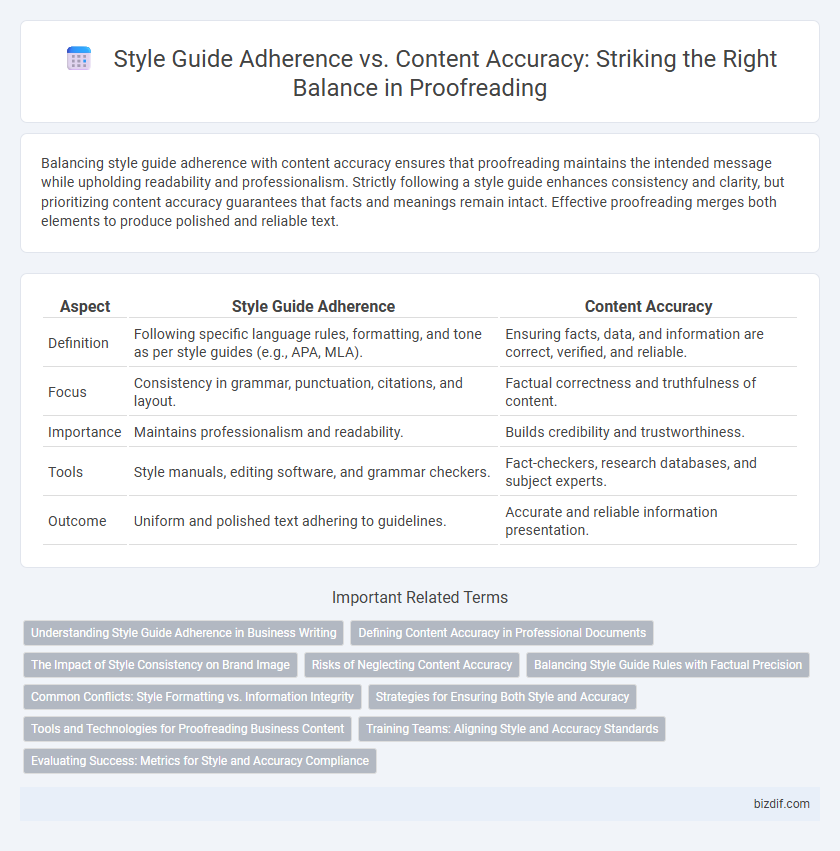Balancing style guide adherence with content accuracy ensures that proofreading maintains the intended message while upholding readability and professionalism. Strictly following a style guide enhances consistency and clarity, but prioritizing content accuracy guarantees that facts and meanings remain intact. Effective proofreading merges both elements to produce polished and reliable text.
Table of Comparison
| Aspect | Style Guide Adherence | Content Accuracy |
|---|---|---|
| Definition | Following specific language rules, formatting, and tone as per style guides (e.g., APA, MLA). | Ensuring facts, data, and information are correct, verified, and reliable. |
| Focus | Consistency in grammar, punctuation, citations, and layout. | Factual correctness and truthfulness of content. |
| Importance | Maintains professionalism and readability. | Builds credibility and trustworthiness. |
| Tools | Style manuals, editing software, and grammar checkers. | Fact-checkers, research databases, and subject experts. |
| Outcome | Uniform and polished text adhering to guidelines. | Accurate and reliable information presentation. |
Understanding Style Guide Adherence in Business Writing
Understanding style guide adherence in business writing ensures consistent tone, format, and terminology, enhancing professionalism and brand identity. Strict compliance with style guides streamlines communication by reducing ambiguities and aligning content with organizational standards. Balancing style guide rules with content accuracy prevents misinterpretations while maintaining clarity and credibility in corporate communications.
Defining Content Accuracy in Professional Documents
Content accuracy in professional documents ensures all facts, figures, and statements are correct and verifiable, directly impacting the document's credibility and effectiveness. Precise data representation and consistent use of terminology reinforce the reliability of the information presented, minimizing misunderstandings and errors. Unlike style guide adherence, which focuses on formatting and language rules, content accuracy prioritizes factual correctness and clear communication of key messages.
The Impact of Style Consistency on Brand Image
Maintaining strict adherence to a style guide ensures consistent tone, terminology, and formatting, which strengthens brand identity and fosters audience trust. In contrast, content accuracy verifies factual correctness but without stylistic uniformity, messages may appear fragmented or unprofessional. Consistent style use enhances brand recognition by delivering a cohesive user experience across all communications, reinforcing credibility and brand loyalty.
Risks of Neglecting Content Accuracy
Neglecting content accuracy in proofreading can lead to the dissemination of false or misleading information, damaging the credibility of the author and publication. Errors in data, facts, or critical details may result in legal liabilities, loss of audience trust, and reduced effectiveness of the message. Ensuring accuracy is essential to maintain authority and guarantee that the information serves its intended purpose without causing confusion or harm.
Balancing Style Guide Rules with Factual Precision
Balancing style guide adherence with content accuracy ensures that written material maintains both clarity and reliability. Strict compliance with style rules enhances readability, while prioritizing factual precision upholds the integrity of the information presented. Effective proofreading harmonizes these elements, producing polished content that is both consistent and trustworthy.
Common Conflicts: Style Formatting vs. Information Integrity
Style guide adherence often emphasizes consistent formatting, punctuation, and tone, which may sometimes clash with maintaining information accuracy when strict rules alter nuanced content. Common conflicts arise when style protocols require rephrasing that risks distorting original data or key details, challenging proofreaders to balance clarity and fidelity. Prioritizing information integrity ensures that essential facts remain accurate, even if slight deviations from the style guide occur for optimal content precision.
Strategies for Ensuring Both Style and Accuracy
Effective proofreading balances style guide adherence with content accuracy by implementing dual-layer review processes that first verify grammatical consistency and then validate factual information against trusted sources. Utilizing specialized software tools alongside human editors enhances the detection of style deviations and factual errors, ensuring comprehensive quality control. Regular training on evolving style standards combined with fact-checking protocols promotes continuous improvement in maintaining both stylistic integrity and content reliability.
Tools and Technologies for Proofreading Business Content
Advanced proofreading tools leverage AI algorithms to ensure both style guide adherence and content accuracy with high precision. Technologies such as natural language processing (NLP) and machine learning enable automated detection of stylistic inconsistencies, grammar errors, and factual inaccuracies in business documents. Integrating platforms like Grammarly Business and ProWritingAid enhances efficiency by providing real-time feedback aligned with corporate style guides and verified content standards.
Training Teams: Aligning Style and Accuracy Standards
Training teams to balance style guide adherence with content accuracy enhances overall communication quality and brand consistency. Emphasizing detailed style guidelines alongside accuracy checks ensures that content meets both editorial standards and factual correctness. Integrating targeted workshops and regular feedback loops strengthens team capability in producing precise and stylistically aligned content.
Evaluating Success: Metrics for Style and Accuracy Compliance
Evaluating success in proofreading requires measuring both style guide adherence and content accuracy through specific metrics such as consistency scores and error detection rates. Style compliance can be quantified by tracking conformity to prescribed grammar, punctuation, and formatting rules, while content accuracy metrics focus on factual correctness and clarity of the information presented. Combining these data points allows for a comprehensive assessment of a document's overall quality and effectiveness.
Style guide adherence vs Content accuracy Infographic

 bizdif.com
bizdif.com